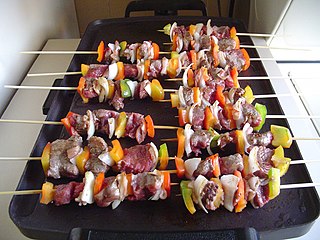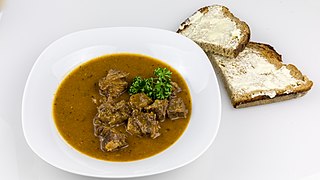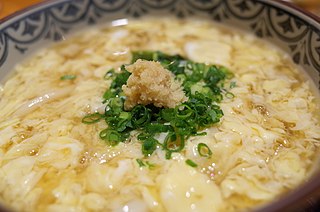
Chicken soup is a soup made from chicken, boiled, in water, usually with many other ingredients. The classic chicken soup consists of a clear chicken broth, often with pieces of chicken or vegetables or turkey; common additions are pasta, noodles, rices, or grains such as rice and barley. Chicken soup has acquired the reputation of a folk remedy for colds and influenza, and in many countries is considered a comfort food.

Noodle soup refers to a variety of soups with noodles and other ingredients served in a light broth. Noodle soup is a common dish across East Asia, Southeast Asia and the Himalayan states of South Asia. Various types of noodles are used, such as rice noodles, wheat noodles and egg noodles.

Sopa de mondongo is a soup made from diced tripe slow-cooked with vegetables such as bell peppers, onions, carrots, cabbage, celery, tomatoes, cilantro, garlic or root vegetables. The dish is generally prepared in former Spanish colonies in Latin America, Caribbean, and in the Philippines.

Colombian cuisine is a compound of the culinary traditions of the six main regions within Colombia. Colombian cuisine varies regionally and is particularly influenced by Indigenous Colombian, Spanish, and African cuisines, with slight Arab influence in some regions. As one of the most biodiverse countries in the world, Colombia has one of the widest variety of available ingredients depending on the region.

Honduran cuisine is a fusion of Mesoamerican, Spanish, Caribbean and African cuisines. There are also dishes from the Garifuna people. Coconut and coconut milk are featured in both sweet and savory dishes. Regional specialties include sopa de caracol, fried fish, tamales, carne asada and baleadas. Other popular dishes include meat roasted with chismol and carne asada, chicken with rice and corn, and fried fish with pickled onions and jalapeños. In the coastal areas and the Bay Islands, seafood and some meats are prepared in many ways, including with coconut milk. Among the soups the Hondurans enjoy are bean soup, mondongo soup, seafood soups and beef soups. Generally all of these soups are mixed with plantains, yuca, and cabbage, and served with corn tortillas.

Caldo de costilla is a dish typical of Colombian cuisine, from the Andean region. It is made mainly from beef ribs boiled in water with slices of potato, some garlic, onion and cilantro leaves.

Haejang-guk or hangover soup refers to every kind of guk or soup eaten as a hangover cure in Korean cuisine. It means "soup to chase a hangover" and is also called sulguk (술국). It usually consists of dried napa cabbage, vegetables and meat in a hearty beef broth. One type of haejangguk, seonjiguk, includes sliced congealed ox blood and another type, sundaeguk, includes a kind of blood sausage made with intestine stuffed with pig's blood and other ingredients.

Oxtail soup is a soup made with beef tails. The use of the word "ox" in this context is a legacy of nomenclature; no specialized stock of beef animals are used and tails may come from bovines other than oxen. It is believed by some that oxtail soup was invented in Spitalfields in London in the seventeenth century by French Huguenot and Flemish immigrants, from the tails of animals. Different versions of oxtail soup exist: Korean; Chinese; a fried/barbecued oxtail combined with soup variation which is a popular dish in Indonesia where it is called as sop buntut; an ethnic dish of the American South which traces its lineage back to the pre-revolutionary war era; and a thick, rich, gravy-like soup popular in the United Kingdom since the 18th century. Creole oxtail soup is made from a tomato base with oxtails, potatoes, green beans, corn, mirepoix, garlic, and herbs and spices.

Lablabi or lablebi is a Tunisian dish based on chickpeas in a thin garlic and cumin-flavoured broth, served over small pieces of stale crusty bread.

Soup is a primarily liquid food, generally served warm or hot, that is made by combining ingredients of meat or vegetables with stock, milk, or water. Hot soups are additionally characterized by boiling solid ingredients in liquids in a pot until the flavors are extracted, forming a broth. Soups are similar to stews, and in some cases there may not be a clear distinction between the two; however, soups generally have more liquid (broth) than stews.

Gopchang-jeongol (곱창전골) or beef tripe hot pot is a spicy Korean stew or casserole made by boiling beef tripe, vegetables, and seasonings in beef broth. Gopchang refers to beef small intestines, while jeongol refers to a category of stew or casserole in Korean cuisine. Although the dish is mainly based on beef gopchang, other parts of beef innards are also used to give the dish a richer flavor and chewy texture.
Sungeo-guk (숭어국) is a variety of guk, or Korean soup, made with flathead grey mullet and black pepper. It has a clear broth seasoned with salt, minced garlic, ginger juice, and chopped scallions.

Mie celor, is a Southeast Asian noodle soup dish served in a coconut milk and shrimp-based broth, specialty of Palembang city, South Sumatra, Indonesia.

Egg drop soup, also known as egg flower soup, is a Chinese soup of wispy beaten eggs in chicken broth. Condiments such as black or white pepper, and finely chopped scallions and tofu, are commonly added to the soup. The soup is made by adding a thin stream of beaten eggs to the boiling broth in the final moments of cooking, creating thin, silken strands or flakes of cooked egg that float in the soup.

Hot pot or hotpot, also known as steamboat, is a dish whereby a heat source placed on the dining table keeps a pot of soup stock simmering, and a variety of Chinese foodstuffs and ingredients are served beside the pot for the diners to put into the hot stock.

Brenebon soup or bruinebonensoep is a kidney beans soup commonly found in the Eastern Indonesia, more often specifically associated with Manado cuisine of North Sulawesi. The soup is made from kidney beans with vegetables served in broth seasoned with garlic, pepper and other spices.

Indonesian noodles are a significant aspect of Indonesian cuisine which is itself very diverse. Indonesian cuisine recognizes many types of noodles, with each region of the country often developing its own distinct recipes.















